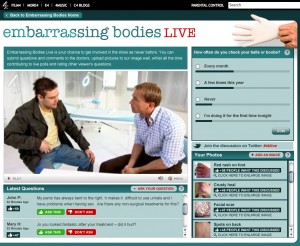 “Don’t be embarrassed by your body. Learn to love it,” the voice on the video positively commands.
“Don’t be embarrassed by your body. Learn to love it,” the voice on the video positively commands.
Comcast, are you listening?
Channel 4 in the United Kingdom hosts the television show, Embarrassing Bodies. There’s also a website providing health information that is detailed, audacious, graphic, and absolutely engaging.
On it, you’ll see close-ups of breasts, testicles, vulvae, and most other body parts in Grey’s Anatomy that are suitable for self-examination.
The show launched in April 2008 and was watched by over 12 million people. Since there, Embarrassing Bodies has seen countless downloads of health videos, page views on every topic of consumer health care,
The website houses self-check videos that help people learn about conditions from A to Z (er, zed), from “acne” to “zits,” from the esoteric xanthelasma (cholesterol deposits underneath the skin under the eyes) to the more common genital herpes (both, graphically illustrated).
As Adam Gee, Commissioning Editor of Channel 4, said, the program, “helps people to avoid literally dying of embarrassment.”
To download a video to educate you for a breast check, for example, you would text “boobs” to 83188 to download the video to your mobile phone in the UK. Carrying the health video on a mobile phone enables people to do a check in private, wherever they deem is private for them — even away from their home DVR which could lead to, well, embarrassment for some very private health citizens.
There are many ways people can use the website:
- To do a health information search via the A-to-Z search portal that spells out health conditions linked to graphic, simple, detailed explanations.
- To calculate health risks for a variety of conditions.
- To check for sexually transmitted infections and diseases (STIs and STDs).
- To download health videos, both on computers and mobile phones.
There’s also an Embarrassing Teenage Bodies portal which is particularly helpful when health literacy among teens is dismally poor – and dangerous. In this section, there are hyperlinks to places like “Am I Normal” and “Below the Belt.”
My colleague and friend Michael Millenson (author of the sage book, Demanding Medical Excellence) pointed me to this site. He’s always spot-on!
Health Populi’s Hot Points: How would this site fare for a U.S. audience. It’s great stuff — highly engaging and very user-friendly — of course, depending on the user and his/her lens on “the body.”
To put my intuition in context, I was struck today by a Harris survey. What People Do and Do Not Believe In, on Americans’ attitudes about Creationism versus Darwinism. The poll found that 45% of Americans believe in Darwin’s theory of evolution, while 40% believe in Creationism. 42% also believe in ghosts.
While a great many Americans would visit an Embarrassing Bodies-type site for health empowerment, I would forecast a great percentage of American health citizens would find such a site too graphic, perhaps even pornographic. I say this wearing my public health hat. What I see as a relatively low proportion of Americans who believe in evolution informs my forecast.
And I find it downright, well, embarrassing as well as highly health risk-y. “Don’t feel the shame. We’re all the same,” is the mantra of Embarrassing Bodies. Amen!
 “Don’t be embarrassed by your body. Learn to love it,” the voice on the video positively commands.
“Don’t be embarrassed by your body. Learn to love it,” the voice on the video positively commands.



 Interviewed live on BNN Bloomberg (Canada) on the market for GLP-1 drugs for weight loss and their impact on both the health care system and consumer goods and services -- notably, food, nutrition, retail health, gyms, and other sectors.
Interviewed live on BNN Bloomberg (Canada) on the market for GLP-1 drugs for weight loss and their impact on both the health care system and consumer goods and services -- notably, food, nutrition, retail health, gyms, and other sectors. Thank you, Feedspot, for
Thank you, Feedspot, for  As you may know, I have been splitting work- and living-time between the U.S. and the E.U., most recently living in and working from Brussels. In the month of September 2024, I'll be splitting time between London and other parts of the U.K., and Italy where I'll be working with clients on consumer health, self-care and home care focused on food-as-medicine, digital health, business and scenario planning for the future...
As you may know, I have been splitting work- and living-time between the U.S. and the E.U., most recently living in and working from Brussels. In the month of September 2024, I'll be splitting time between London and other parts of the U.K., and Italy where I'll be working with clients on consumer health, self-care and home care focused on food-as-medicine, digital health, business and scenario planning for the future...